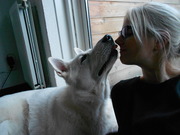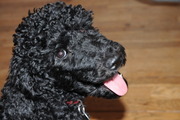Yakutian Laika 
Helaas, dit onderwerp staat op slot.
Dit komt doordat het onderwerp niet meer recent is en in het hondenforum archief terecht ik gekomen.
Als je over "Yakutian Laika" wilt praten in het hondenforum dan kun je het beste een nieuw onderwerp aanmaken
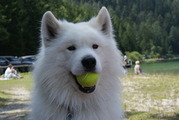
Maaike, bedoel jij Karin de R?
Daar heb ik de foto's ook van op facebook gezien.
Ook met een filmpje. Prachthonden.
Laura, jij hebt mooie foto's gevonden. Ik zoek me verloren maar kom steeds dezelfde tegen.
Ik vind met meer tekening zeker ook prachtig.
Lijkt me een mooie combi met mijn Samojeed 
 Witte Draak
Witte Draak
 3 doggies
3 doggies
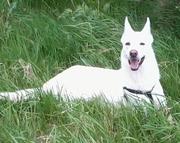
Geen wonder dat ik er nog niet van had gehoord. Ik heb pas nog een lijst gemaakt van zo'n beetje álle rassen die geen kruisingen zijn en daarbij gebruik gemaakt van de lijsten van de FCI, American Kennel Club, Kennel Club (U.K.), Australian Kennel Club, en alles wat te vinden was op de Engelse Wikipedia (want van alle talen staat daar de meeste info op).
De Engelse Wikipedia heeft geen artikel over de Yakutian Laika... maar de Duitse wel. De http://de.wikipedia.org/wiki/Jakutischer_Laika. Je moet maar net van het ras gehoord hebben ergens.
Maar snel toevoegen aan m'n lijst... 
 Bella
Bella  3 doggies
3 doggies
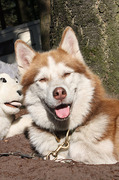
wow; dat is een prachtbeest zeg! die zou ik wel eens in een team langs willen zien komen! 
 Amber & Lootah
Amber & Lootah  3 doggies
3 doggies
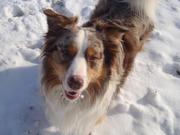
Ik kende deze variatie van de laika ook nog niet (ik weet wel dat er heel veel zijn) en ik vind het echt pracht honden!!!! 
Anoniem (Gast)
Zie dat men de Yakoot gevonden heeft.
Ik woon in Nederland, NB en heb 1 raszuivere YL en een Kruising YL & Samojeed
M`n raszuivere YL heb ik uit Rusland Yakutsk geïmporteerd en inderdaad in Duitsland zit een fokster, zij heeft ook Samojeden.
In Frankrijk zitten inmiddels ook 2 een reu en teef en zij is indien ze voldoen aan alle eisen voornemens ook te fokken.
Helaas is de basis heel smal en moeten we opletten met wat we doen.
De link die Huskywoman door heeft gegeven bestaat niet meer, kan geen link plaatsen maar als je zoekt op arctic sobaki kom je op de nieuwe site
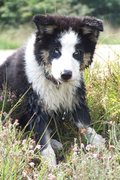
Ik woon in Nederland, NB en heb 1 raszuivere YL en een Kruising YL & Samojeed

M`n raszuivere YL heb ik uit Rusland Yakutsk ge�¯mporteerd en inderdaad in Duitsland zit een fokster, zij heeft ook Samojeden.
In Frankrijk zitten inmiddels ook 2 een reu en teef en zij is indien ze voldoen aan alle eisen voornemens ook te fokken.
Helaas is de basis heel smal en moeten we opletten met wat we doen.
De link die Huskywoman door heeft gegeven bestaat niet meer, kan geen link plaatsen maar als je zoekt op arctic sobaki kom je op de nieuwe site "
Dit komt dus van mij af, had het getypt en geplaatst en me daarna pas aangemeld

Hoi Karin,
We hebben in dit topic het nog over je gehad 
Maar als jij straks gaat emigreren is er helemaal geen YL meer in Nederland! 
 Karin
Karin  3 doggies
3 doggies

Juist omdat ik mezelf terug vond heb ik me aangemeld 
Duurt nog zeker tot 2013, kunnen dus zeker nog van ons genieten 
Maar wie weet dat er iemand in Nederland een keer zegt yep dit is qua KARAKTER het type hond wat ik zoek.
Kijk naar het karakter en niet naar het uiterlijk, en zeker al helemaal niet naar die mooie blauwe ogen, want ga je puur daarop uit dan kun je nog wel eens voor ver. komen te staan.
Ik heb het ras puur op karakter gekozen en van Kamatz wist ik niet dat hij blauwe ogen kreeg, ik had de keuze uit 2 reuen, en omdat ik heel bewust voor een import reu heb gekozen om de basis wat breeder te maken heb ik voor kamatz gekozen omdat de andere reu een Merle kleur heeft en dit dus een kleur is waar verder niet mee gefokt mag worden, omdat deze kleur over het algemeen steriele honden geeft.
Ze zien er dan zo lief uit, maar je moet er toch rekening mee houden dat de heren er een kop op hebben zitten en dus na een bepaalde leeftijd niet meer met andere reuen kunnen. Mits je dit geregeld doet en veel samen wandeld, en dan nog moet het klikken tussen de honden.
Wij lopen geregeld met een Malamute reu van nu bijna 2 jaar, deze heren kunnen met z`n 3en op een rij lopen met een ruimte er tussen waar je net een vlakke hand tussen legt.
Maar ook hiervan weet ik dat dit een keer over is, ken de vader van deze Malamute reu en weet dat hij een keer haantjes gedrag gaat vertonen.
Reuen die buiten onze roedel staan zijn onder geen beding welkom en zullen dit ook weten.
Mocht er iemand zijn die de YL in levende lijve wil zien, jullie zijn altijd welkom.
Ik ben ook om de 2 weken met de heren in Rhenen om daar te sportspeuren.

Daarom blijft het bij kijken bij mij  . Ze hebben een iets te sterk karakter en we hebben nu een Samojeed en die is eigenwijs genoeg. Het gaat gelukkig nu over het algemeen wel goed met andere reuen.
. Ze hebben een iets te sterk karakter en we hebben nu een Samojeed en die is eigenwijs genoeg. Het gaat gelukkig nu over het algemeen wel goed met andere reuen.
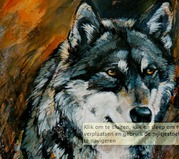
Helaas wijken de foto's welke hier te zien zijn van de Yakutenlaika sterk af van de honden uit Yakutia. Er lijkt veel samojeden invloed en dit is mn ook middels kruisingen in Europa gebeurt. Ik denk dat dit in ieder geval wat uiterlijk betreft een verkeerd beeld kan scheppen.
Wij zijn in Yakutia (siberie) geweest en hebben contact met diegenen ter plekke welke bezig zijn met de fokselecties in Yakutia. Zij hebben oa voor ons een tentoonstelling daar ter plaatse georganiseerd en ons laten kennismaken met wat zij als uitstekende vertegenwoordigers van het ras beschouwden. Hier zaten bv geen woullies (langharige zoals op deze foto's) bij.


Wat type betreft vond ik ze richting groenlandhond gaan. Zij werden in Yakutia veel gebruikt als jachthond op groot wild (oa beer).

De honden welke wij daar ontmoet hebben waren allen zeer sociaal en vriendelijk, net als hun mensen.

History Of The Yakutian Laika
For centuries, dog sledding was most important part of way of life of peoples of the north. Specialists believe that dog sledding is considerably older then reindeer sledding. In Neolithic, on the Northeastern shore line of Asia, what no is a part of Yakutia, dogs were used for transportation and hunting. This is explained by the fact, that in the tundra zone and in the polar desert zone, there were no other animals suitable for using as transportation, but there was an opportunity to obtain enough food for dogs for the whole winter period.
In early 90th of XX century, on Zhokhov Island (the Novosibirsk Archipelago, Yakutia), a hunters archeological site was found. It was investigated by an archeologist from Sanct-Petersburg, Vladimir Pitulko. He found remains of sleds, harness and well preserved bones of dog. Radiocarbon method showed that time of these finds was between 7 800-8 000 years. This is the oldest find in high Arctic.
Ethnographers M. G. Levin (1946), A. V. Smolyak (1978) and others wrote that since ancient time and until present, for aboriginal people of the north, sled dogs served as universal animals: they were draft animals, , they were eaten, their pelts were used for making clothing and for cult rituals; the dogs were sacrificed and used for other religious ceremonies.
Whereas technique of dog sledding of North America remained rather primitive, people of Siberia and of the Far East went considerably further in sledding technique and controlling the dogs. R. Amundsen, in 1920, visited Koren Yukhan, on the Kolyma River (Russian Ustye, Pokhodsk and Nizhnekolymsk). He wrote: “…in the dog sledding these Russians and Yakuts are better, then anyone I could see.”
Northeaster narta (sleds) is a particular achievement. It is called Kolyma sleds. It is light, built without a single nail, only with belts, strong and resilient and is better then any other sleds for riding on uneven terrain covered with rocks and ice. It is believed that this type of sleds was invented still in Neolithic and remained unchanged until present. There are two versions of it, one for shipping heavy loads and one for fast riding.
Many geographic discoveries in the Arctic were possible, because of the sled dogs. Both Earth poles were discovered with help of sled dogs; in 1907, F. Cook and in 1909 R. Piry reached the Northern Pole. In 1911, Amundsen put a Norwegian flag in the South Pole. Under hard conditions, he made 2980 km in 99 days on sled dogs. Amundsen made all his polar expeditions by using our Kolyma Laikas, despite their delivery was difficult and expensive. Samoyed dogs also took part in these expeditions.
American explorers of the Arctic, until 20th of XX century, imported dogs from the Kolyma River region. “Give me winter and a dog team, and take all the rest” – words of the famous traveler of the north Knut Rasmussen, who accomplished the longest trip in dog sleds. This Dutch ethnographer, with his team made 18 000 kilometers from Hudson Gulf to the Chukotka Peninsula. He wrote about this travel: “I feel deep gratitude to our patient and undemanding dogs. We worked as hard as living creatures can work, until exhaustion together with the dogs, helping each other. ..”
In Russia, starting from the Great Polar Expedition sent by Piter I and until 70th of the past century, no one northern traveler could do without dogs. They were used also during more recent time, despite contemporary technological achievements.
The first writing record of dogs on Yakutian territory was made in 1633, when the first travel by sea was made from the Lena River. Ilia Perfiliev was the head of the group of traders and kozaks from Yenissey and Tobolsk regions. As a result of this trip, several geographic discoveries were made: the Olenek, the Yana and the Indigirka Rivers were found and two forts were bult, Zashiversk and Russkoye Ustye. This was the beginning of population and development of Indigirka-Kolyma territories.
The next step of sea travels in the Arctic was made in 1642. Dmitry Zyrtan (Yarilo), Mikhail Stadukhin and Semyon Dezhnev with teams of kazaks (Russian Polar Travels of traders and kazaks in XVII-XIX centuries). In 1643, the seafarers reached mouth of the Kolyma River. They proceeded upstream and built a winter fort named Kolymsky.
In documents of that time, the Olenek River, the Yana River and the Kolyma River are named “Dog Rivers”. In Siberia, rivers are divided into “dog rivers” and “deer rivers”. On rivers rich with fish, it was easy to catch and store enough fish (dried fish – yukola) to feed the dogs and this is why they were called dog rivers. Where no fish, it was hard to use dogs for the transportation and reindeer were used; these are reindeer rivers. Life along dog rivers was more difficult, because of the constant need of fishing and hunting to obtain enough food for the dogs.
French polar explorer, Pol-Emil Victor, in his book “Sled Dogs – Friends in Risk” states that Mc Clintok was he first who used a sled dog team in polar expeditions. This is not true. In 1742, a Russian seaman Semen Ivanovich Chelyuskin made 4000 vest in dog pulled sleds from Yakutain land to Taimyr Peninsula. He was the first who reached northern end of Asia named to day Chelyuskin Cape. His friends, Khariton Laptev and Nikifor Chekin (Lena-Yenissei team, 1735-1742) made thousands of verst in dog sleds.
In 1843, the first part of “Manual to Geography of Russian Empire” by Ivan Yakovlevich Pavlovsky was published. In this book, he described the Yakutian Laika as a special breed, which “is a necessary domesticated animal used for sledding and hunting”. In this book he reports that Yakutian Laikas were used for postal service. In 1839, in Yakutian Province, up to twenty dog sleds were used for communications between Okhotsk and Kamchatka, “which were used for shipping heavy loads. One sled was pulled by 10 dogs, a pair of dogs in the rows attached to one cord and the eleventh dog in the front. Because they pulled heavy loads of 25-35 puds, making 80 verst per day; at the light riding, the same dogs made up to 140 verst.”
According to ethnographer V. Tugolukov, who wrote about Kolyma-Indigirka dog teams of the middle XIX century, average speed in the road less country over long distances was 10 km per hour, on tracks 200-250 km, average speed was 15-17 km per hour. Light sleds could be pulled over 250 km in 15 hours, and 750 km in three days. If the road conditions are good, a team of 12-14 dogs could pull one ton load unlimited time, but on the bad road not more then 500 kg.
The first record of number of Yakutian Laikas can be found in a book “Statistical Tables of the Russian Empire” published by Ministry of Inner Affairs of Russian Emipre, 1856, editor A. Bushchev: “In Yakutian Province, 15 157 dogs are recorded, which are used there for transportation”.
In 1862, Imperial Geographic Society published “Geographic Statistical Dictionary of Russian Empire, Volume 1st of which was put together by Peter Semenov . According to this publication, in Verkhoyansk Ulus, “Dogs belong to very important domesticated animals of local people, which keep them in great numbers. They use them for transportation in tundra and for hunting. Total number of dogs is up to 4 000”.
The first description of keeping and using of Yakutian Laikas can be found in “Review of Economical Statre and Statistics of Russian Empire, 1849” put together by G. Gorlov, “Yakuts use dogs for riding and shipping loads. Dogs live outside a year around; in the summer they dig pits in the dirt for staying cool, or they lay in water, trying to get rid off mosquitoes. In winter, they seek for shelter, hiding under snow, lay in pits dug in the snow, covering muzzle with tail.
Only males are raised, but females are discarded. Feeding and training dogs for transportation is a major occupation of fishermen population. Fastest and most intelligent dogs are hitched in the front. Traveling in vast tundra, in dark and foggy nights, or in blizzard, when trqaveller can see nothing and there is a danger to die in the snow, well trained lead dog saved form eminent death by taking the traveler to the shelter, where it had been at least one time. This alone makes dogs necessary; their sense of smell and instinct in polar deserts replace compass.”
“In 1821, disease exterminated most of the dogs” “On the river banks of Lena, Indigirka and Kolyma, in some families with 20 dogs, only two puppies survived: the woman of the household fed them up with her breast along with her own child. This is how much the dogs are needed. This is how two puppies became ancestors of numerous progeny”.
The first researcher, who had described the Yakutian Laika in details was Vladimir Iliych Yokhelson. In 1894-1900, his first publications associated with this expedition were published. They were a result of extensive and diverse investigations by V. I. Yokhelson in life of Yukagir, Chukchi, Chuvans, Yakuts, Evens, Evenks and Russians.
Yokhelson put together Russian-Yukagir and Yukagir-Russian Dictionaries; presented several samples of Yukagir texts with his translations and grammar analysis, Yukagir letters and drawings on birch bark, archive excerpts and about 100 archive documents, ethnographic collection and travel notes. He collected materials on folklore, linguistic, anthropology, family life, religion, customs, material culture and economics of Yukagir people. In the book by Yokhelson we read: “Domesticated animal of Yakuts is horse; nomadic Yakuts keep reindeer and river Yakuts as well as settled ones, keep only dogs. All these animals are adapted to serve people at the hunting. By the way, dogs, which follow people at all latitudes, it is necessary to add that it is most reliable friend during hunting. Whereas horse and reindeer are passive, unconscious and involuntary assistants, the dog, being clever predator, is active and conscious worker, which sometimes even leads another predator – the human.”
Yokhelson writes: “Sleddog is working livestock of not only reindeer less nomads and settled river dwellers, but also of Russians and russified minorities and of majority of livestock keeping Yakuts. Excluding southwestern part of the territory, every Yakut yurta (house) has 3-4 dogs, which ship firewood, ice and do other work. Polar dogs are not big, 50-60 cm at shoulder. They can be bigger, but many of Yakutian dogs are surprisingly small. Small size of working dogs can be explained by the same reasons why our peasants have small horses; five-six months old puppies of poor people are not fed well, but used for shipping water and firewood. Rich owners take better care of their dogs and those dogs are always bigger.
In the appearance, local sled dog with its prick ears, slanted set eyes, thick coat, broad and relatively big head, pointed muzzle and bushy low kept, when not in a good mood, tail is very similar to wolf.”
Vladimir Ilyich Mikhelson was the first who described the Yakutian Laika and distinguished it from other dogs of northeastern Asia.
Predominant coat color of the Kolyma dog, according to Yokhelson, is “gray, gray-red, spotted, in other words, with white or black spots. Legs are relatively thick and short; chest, which is used to pull sleds, is well developed; neck is thick and short. Face is extraordinary shrewd, with melancholic or aloof expression”.
According to Yokhelson, the same dog is used for sledding and for hunting, with well developed sense of smell, but with even better hearing and vision. They live tethered almost a year around, but when on the loose, they find food for themselves in a form of mice, partridges, ducks and other birds and small mammals. When groups, they can kill a reindeer, a cow and, if hungry will attack a horse.”
Interesting that during sledding, Kolyma dog become vicious and become dangerous even to humans. As to the hunting, they are worthless for hunting birds: they frighten all forest and swamp birds.”
“By the way, hunting birds there is very different from bird hunting in our country and dogs are never used for this purpose. Nobody is teaching these dogs. A good hunting dog is a natural talent. Any of local dogs can chase and find animals by tracks, but not each of them has enough courage and determination to finish the job”.
M. G. Dmitrieva-Sulima made a particular contribution in the description of the Yakutian Laika in her book “Laika and Hunting with Laika”, 1911: “This dog, by its qualities, belongs to breed of northern dogs. It is living in the Kolyma Teritory, north of the Kolyma River with its tributaries. It is known that for 300-400 years this dog is forced to work as a draft animal, which did not kill its hunting instincts. Without being developed and maintained by training, they still remain strong enough to classify it as a hunting breed. Small number of them can hunt big game, they all are treeing squirrels, most of them can catch red foxes and polar foxes; shortly all those animals, which are hunted in that country by local people. In this country the northern dog became what people wanted it to be.”
Until 1960th sled dog teams were important and sometimes the only one available form of winter transportation in northern regions of Russia. They were used not only by local people, but also by the government agencies, including border troops, postal service and scientific expeditions. According to archival data, in late 50th of XX century, in northern uluses of Yakutia, total number of dogs was 33 000. Decline of dog sledding in Russia began during recent 30 years of XX century. Snowmobiles, decline of fur industry and local fishing led to extinction of sled dogs.
In 1993, Government Commission of the Russian Federation for preservation of genetic achievements included the Yakutian Laika in the Government’s roster of useful animals under Number 9358072 as a hunting and working (sled) dog.
In 1998, a group of enthusiasts, V. Z. Dyachkov, G. P. Arbugaev, S. V. Gorodilov and L. I. Sidorova decided to reclaim the Yakutian Laika breed. They brought first dogs, which became a foundation stock of the Yakutian Laika in Yakutia. Jointly with the Yakutian Republican Association of Dog breeding, during several years they bred dogs and put together the breed standard.
In 2004, Russian Cynological Federation (RKF) examined the breed standard and accepted it as a basic breed standard.
De honden die nu ingeschreven zijn in het RKF zijn de honden die voldoen aan de standaard.
Omdat het een ras in opbouw is, is er vaak van de voorouders niks of weinig bekend.
Wat betreft de vriendelijkheid naar mensen, klopt, maar als ze uitgedaagd worden zullen ze die uitdaging aan gaan.
Wat overigens een zeer natuurlijke reactie is.
Reuen onderling, zelfs de Russen hebben hun reuen niet samen zitten.
Hier gaat het met de ene wel de andere niet en daarbij is het normaal en natuurlijk gedrag dat vreemde honden niet zomaar geaccepteerd worden in de roedel.
Zolang de heren hier samen kunnen ben ik tevreden.

NB Russen zijn totaal andere mensen als Siberiers en houden blijkbaar ook hun honden anders, wij zagen bij de Siberiers (Yakuten) wel de reuen bij elkaar, zonder problemen.
Agressie naar mensen werd sowieso absoluut niet getolereerd en ben ik ook niet tegen gekomen (uitgezonderd bij de Russisch Europese laiki).
Olga (Gast)
Dag!!! Ik woon in Belgie al zes jaar, ik ben zelf een Yakutische))) ik ken deze honden zeer goed.Als u wil meer info, stuur aub ,aan mij een email. [email protected] alle beste!!!
joelle (Gast)
wat koel ik wou ook eens met sleehonden want ik hou van honden vooral van husky ,s 
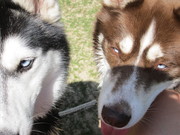
Wauw wat gaaf ik ben heel benieuwd naar hun karakter ga me er gelijk eens in verdiepen! Bedankt voor het delen 
Karin (Gast)
Beter laat dan nooit Deborah 
Ik heb 2 reuen, 1tje van 4 jaar luisterd naar de naam Kamatz en 1tje van 7 mnden die luisterd naar de naam Amarok.
Karin ( inlog gegevens kwijt ) (Gast)
gezien en geaccepteerd 


Amarok onze nu 7 maanden jonge reu

Kamatz onze 4 jaar jonge clown
In mijn eerdere post staat dat ik ook een kruising Yakutian laika & Samoyeed heb, helaas hebben we deze kanjer op nog geen 4 jarige leeftijd moeten laten gaan 
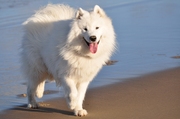
Jeetje Karin ,ineens kwam ik dit topic weer tegen en lees dat je jullie samojeed met 4 jaar heb moeten laten inslapen............pff dat is verschrikkelijk.Mag ik vragen waardoor.
En wat een prachthonden zijn Amarok en Kamatz.

Onze Mauyak YL&Samoyeed bleek meerdere hersentumoren te hebben.
Vorig jaar knapte er iets bij hem en van het 1 op het andere had ik aan 1 arm een gat van 5 cm groot, 5 cm de diepte in en tot op het bot. Slagader geraakt en m'n andere arm had hij gatenkaas van gemaakt, z'n 20 gaatjes van de hoektanden.
Het gegil en de angst/paniek in z'n ogen hoor en zie ik nog steeds, maar alle puzzel stukjes vielen nu wel op z'n plaats.
Dank je, het zijn 2 heerlijke heren 

Oh leuk topic! De Yakut staat al een tijd op mijn favoriete rassen lijst. Al passen 'full-time sledehonden' meer bij mij qua karakter dan de -deels- jachthonden. Wat een verschil zeg, in die foto's. Niet te geloven wat westerse invloed allemaal met een ras kan doen. Helaas is dat ook bij Siberische husky's het geval..
Een stel mooierds heb jij, Karin. En wat vreselijk van je kruising!  Zo jong nog, arm beestje. Goed dat jullie hem uit zijn lijden konden verlossen.
Zo jong nog, arm beestje. Goed dat jullie hem uit zijn lijden konden verlossen.
Helaas, dit onderwerp staat op slot.
Dit komt doordat het onderwerp niet meer recent is en in het hondenforum archief terecht ik gekomen.
Als je over "Yakutian Laika" wilt praten in het hondenforum dan kun je het beste een nieuw onderwerp aanmaken

- Zoeken op de HondenPage
-
Zoek je iets op de HondenPage ? Vul dan hier jouw zoekwoorden in ?

